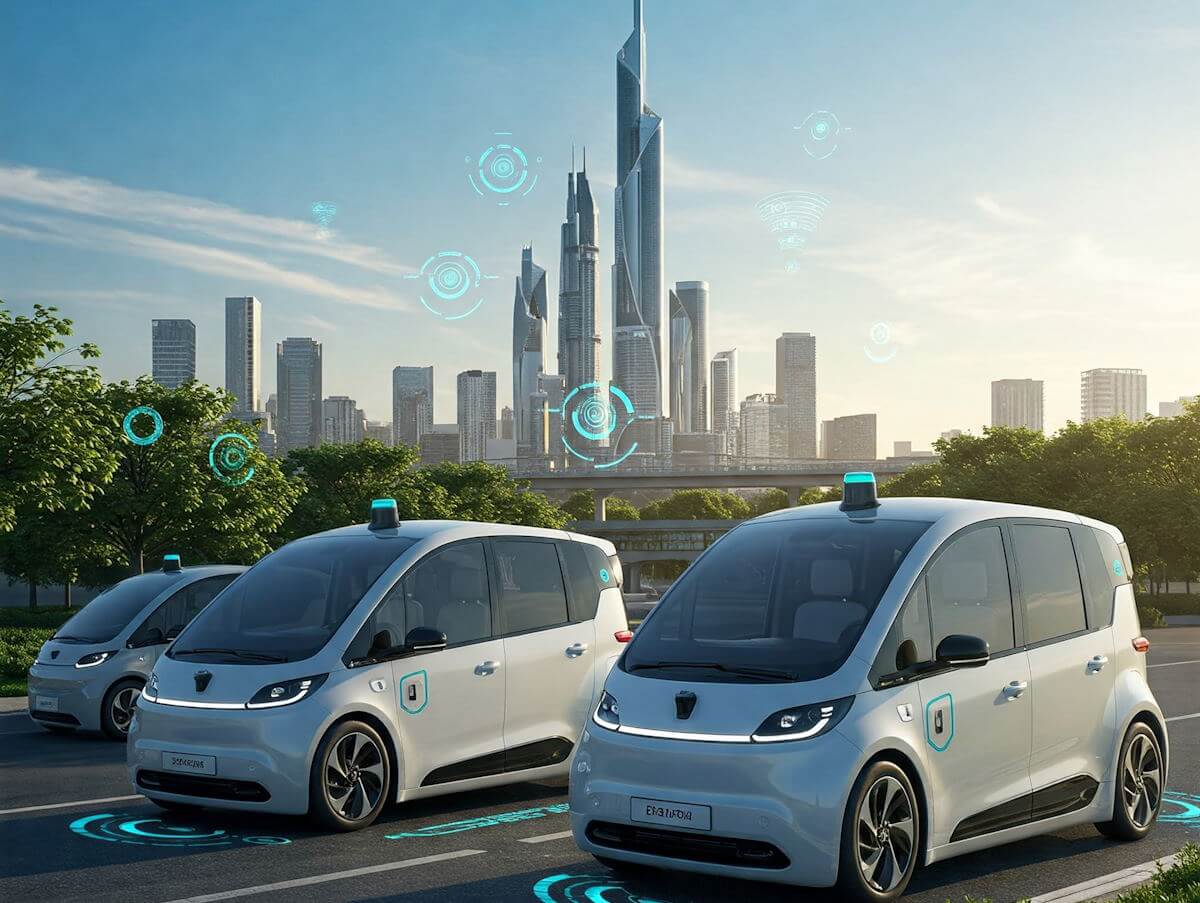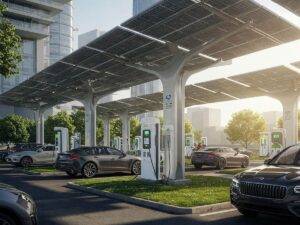Autonomous Electric Vehicles (EVs) represent a significant advancement in automotive technology, merging the capabilities of self-driving systems with the advantages of electric powertrains. At the core of autonomous vehicles is a blend of artificial intelligence, machine learning, and sensor technologies that enable the vehicle to navigate, make decisions, and operate without human intervention. These innovative technologies rely on various sensors, including LiDAR, cameras, and radar, to perceive and interpret the surrounding environment, ensuring safe and efficient operation on the road.
The adoption of electric vehicles has garnered considerable attention for their potential to reduce carbon emissions and decrease dependency on fossil fuels. As the global push for sustainable transportation intensifies, the combination of autonomous driving and electric power amplifies these environmental benefits. Electric vehicles produce zero tailpipe emissions, thus enhancing air quality, particularly in urban areas where traffic congestion is commonplace. The transition to autonomous EVs promises not only to revolutionize individual mobility but also to contribute positively to broader ecological goals.
Investment in the sector has surged, with major automakers, technology companies, and startups racing to develop and deploy autonomous driving systems. The growth of this market is propelled by advancements in connectivity, data analytics, and regulatory frameworks that facilitate the testing and deployment of self-driving technology. Stakeholders recognize the transformative potential of integrating automation with electrification, paving the way for smarter transportation solutions. These vehicles hold the promise of increased safety, reduced traffic congestion, and enhanced accessibility for all users, including those with mobility challenges.
As interest in autonomous electric vehicles expands, the implications for the transportation landscape are profound, setting the stage for discussions surrounding their widespread adoption and the future of mobility.
The Current State of Autonomous Vehicle Technology
The landscape of autonomous vehicle technology has witnessed remarkable advancements in recent years, driven primarily by innovations in sensors, artificial intelligence, and machine learning. At the forefront of these developments are advanced driver-assistance systems (ADAS), which utilize a variety of sensors, including LiDAR, radar, and camera systems. These technologies enable vehicles to detect their surroundings with increasing precision, facilitating safer driving experiences. Major companies such as Waymo, Tesla, and Cruise have made significant strides in refining these technologies, pushing the boundaries of what is possible in self-driving capabilities.
The Society of Automotive Engineers (SAE) has established a framework categorizing the automation of vehicles into six distinct levels, ranging from Level 0, where there is no automation, to Level 5, which represents full automation without human intervention. As of now, most commercially available vehicles fall within Level 2 or Level 3 automation, allowing for certain automated tasks under specific conditions. However, several companies are actively testing Level 4 capabilities in controlled environments, paving the way for broader adoption in the near future.
Current models undergoing testing, such as those by Tesla’s Full Self-Driving (FSD) beta and Waymo’s fully autonomous vehicles, exemplify the industry’s efforts to refine the driving experience and enhance safety through automation. These models vary significantly in terms of their capabilities and deployment strategies. Moreover, industry leaders are collaborating with regulatory bodies to address safety and legal challenges associated with autonomous vehicle deployment, ensuring that advancements align with public interest and safety standards.
As we examine the current state of autonomous vehicle technology, it becomes evident that while significant progress has been made, a comprehensive understanding and acceptance of these systems among consumers and regulators are crucial for the future of self-driving cars.
Regulatory Landscape for Self-Driving Cars
The regulatory landscape for autonomous vehicles presents significant challenges as governments struggle to keep pace with the rapid advancements in self-driving technology. Existing laws and regulations governing road use, safety standards, and liability frameworks were primarily developed for conventional vehicles, leaving a gap in comprehensive legislation tailored specifically for the unique characteristics of self-driving cars. This disparity necessitates an evaluation of current legal frameworks, as they may inhibit the integration and widespread adoption of autonomous vehicles.
Different regions across the globe have approached the regulation of self-driving cars with varying degrees of progress and effectiveness. In the United States, for instance, the approach has been largely driven by state governments, resulting in a patchwork of regulations that can vary significantly from one state to another. Some states have enacted specific laws facilitating testing and deployment of autonomous vehicles, while others remain more cautious, complicating the operational landscape for manufacturers. Meanwhile, the European Union is working on a more unified regulatory framework, which may promote standardization but faces challenges due to the diverse nature of its member states.
Moreover, safety remains a primary concern within the regulatory context. Governments are tasked with establishing rigorous safety standards to ensure that autonomous vehicles meet defined criteria before they can be deployed on public roads. This includes scrutinizing the technology used in self-driving systems, including sensor accuracy, software reliability, and emergency response mechanisms. Additionally, liability issues surrounding accidents involving autonomous vehicles require careful consideration to clarify the responsibilities of manufacturers, software developers, and vehicle operators.
In conclusion, the regulatory landscape for autonomous vehicles is complex and still evolving. As governments and industry stakeholders work collaboratively to address these challenges, it is crucial to create a robust framework that not only promotes innovation but also ensures the safety and security of all road users. With these developments, the potential for self-driving cars to revolutionize transportation systems becomes increasingly tangible.
Public Perception and Consumer Acceptance
The adoption of autonomous electric vehicles (EVs) hinges significantly on public perception and consumer acceptance. Research has shown that various factors, including societal attitudes, education, and personal experiences, play a crucial role in shaping how individuals perceive self-driving technology. Surveys conducted globally reveal that while some consumers exhibit enthusiasm for the potential advantages of autonomous EVs, such as enhanced safety and reduced traffic congestion, others remain apprehensive due to fears and misconceptions.
Common concerns regarding self-driving cars include safety, reliability, and loss of control. A significant portion of the population worries about the ability of autonomous systems to respond adequately in complex, real-world situations, leading to skepticism about their overall safety. Furthermore, media portrayals of accidents involving autonomous vehicles can exacerbate these fears, creating a narrative that focuses more on the risks than the potential benefits. Addressing these concerns requires comprehensive public education campaigns that demystify the technology, illustrating its safety features and providing transparent data regarding its performance in various scenarios.
Trust is another critical component in consumer acceptance of autonomous EVs. For individuals to feel comfortable entrusting their safety to a vehicle devoid of human intervention, they must have confidence in the underlying technology. This trust can be fostered through consistent and reliable performance, coupled with robust regulatory standards to oversee autonomous vehicle deployment. Engaging consumers in dialogue about their preferences and fears, while showcasing real-life success stories of autonomous driving, can further strengthen public trust. Ultimately, the journey towards widespread acceptance of self-driving cars is a multi-faceted endeavor that extends beyond technology alone, encompassing consumer education, addressing misconceptions, and building trust in this transformative innovation.
Market Trends and Future Predictions
The autonomous electric vehicle (EV) market is rapidly evolving, with several key trends indicating a strong trajectory towards mainstream adoption. Significant investment from both traditional automotive manufacturers and new tech companies has accelerated the development of self-driving technology. Major players like Tesla, Waymo, and General Motors are investing billions into research and development, aiming to enhance the safety and efficiency of autonomous systems. This financial backing has not only driven innovation but has also encouraged smaller startups, looking to carve out a niche within this competitive landscape.
Recent reports suggest that the global autonomous vehicle market could reach over $1 trillion by the year 2030, primarily driven by the dual factors of consumer demand for convenience and increased regulatory support for self-driving technologies. These investments illustrate a clear commitment to transforming the automotive sector, with trends showing a convergence of artificial intelligence, machine learning, and advanced driver-assistance systems. Furthermore, the rise of ride-sharing platforms such as Uber and Lyft may further catalyze the adoption of autonomous EVs, as companies may transition from human-operated vehicles to fleets composed of self-driving cars that promise greater efficiency and lower operational costs.
In terms of expected timelines, many industry experts predict that fully autonomous vehicles will be commonly available for public use in urban environments within the next decade, though regulatory hurdles and societal acceptance may dictate the pace. Issues related to safety, reliability, and public trust remain paramount in current discussions and will play a critical role in shaping the future of autonomous vehicles. As we observe these market trends and ongoing innovations, it becomes increasingly clear that self-driving cars are not merely a futuristic concept, but an imminent reality poised to disrupt the automotive landscape significantly.
Safety Considerations for Autonomous Vehicles
The development of autonomous vehicles (AVs) has garnered considerable attention, particularly regarding their safety implications. When comparing accident rates, studies suggest that self-driving cars could potentially reduce traffic accidents significantly when contrasted with human-driven vehicles. A report from the National Highway Traffic Safety Administration shows that approximately 94% of car accidents are caused by human error, ranging from distracted driving to impaired judgment. Autonomous vehicles, driven by complex algorithms and sensor technology, aim to eliminate many of these human shortcomings by adhering strictly to traffic laws and maintaining constant vigilance.
To enhance safety, manufacturers of self-driving cars are implementing rigorous testing protocols. These encompass both simulated environments and real-world conditions under numerous scenarios, including varying weather conditions and complex urban environments. Moreover, AVs utilize an array of sensors, such as cameras, lidar, and radar, to create a comprehensive view of their surroundings, which contributes to stricter adherence to safety protocols. However, concerns remain regarding the reliability of these systems in unpredictable situations, leading to ongoing discussions about the need for robust fail-safes and redundancy mechanisms.
Furthermore, ethical dilemmas arise in the decision-making processes of autonomous vehicles. For instance, in an unavoidable accident scenario, an AV’s algorithm may be confronted with choices that could harm different individuals. This calls for a set of ethical guidelines that dictate how AVs should prioritize their decisions. Public concerns about liability and accountability in the event of accidents involving self-driving cars also warrant examination. Who is to blame if an AV causes an accident: the manufacturer, the software developer, or the vehicle owner? As these considerations unfold, ensuring public confidence in the safety of autonomous vehicles remains a top priority.
As technology continues to evolve, the interplay between safety measures, ethical considerations, and public perception will play a critical role in the future adoption and regulation of autonomous vehicles.
Impact on Urban Mobility and Infrastructure
The increasing adoption of autonomous electric vehicles (EVs) is poised to significantly influence urban mobility and infrastructure. As self-driving cars become more common, we can expect notable changes in traffic patterns. Autonomous EVs are designed to optimize driving behavior, which may lead to smoother traffic flow and reduced congestion. By intelligently analyzing real-time data regarding traffic conditions, these vehicles can adopt adaptive routing strategies, enhancing overall efficiency on roadways.
Furthermore, the integration of self-driving cars into urban environments could prompt a reevaluation of existing urban planning paradigms. With predicted decreases in the need for parking spaces—resulting from the ability of autonomous EVs to drop passengers off and relocate themselves—cities could repurpose these areas for green spaces, pedestrian paths, or mixed-use developments. This shift in land utilization aims to create more livable and sustainable urban settings, contributing to an improved quality of life for city dwellers.
The implications for public transportation systems are equally significant. Autonomous EVs can complement existing transit options by providing first- and last-mile solutions. By acting as an on-demand supplementary service to traditional public transit, such as buses and trains, self-driving vehicles can enhance accessibility and convenience. For instance, individuals in underserved neighborhoods may benefit from rapid transit to key city hubs, enabling more reliable and efficient travel.
Moreover, the potential for shared autonomous mobility services could further transform urban transport ecosystems. Ride-sharing platforms that incorporate self-driving cars may stir competition and encourage the reshaping of public transport routes and schedules, ultimately leading to a more interconnected transit network. As cities adapt to these innovations, a comprehensive approach integrating autonomous EVs into urban infrastructure will be vital for harnessing their full potential while addressing emerging challenges.
Environmental Benefits of Autonomous Electric Vehicles
Autonomous electric vehicles (AEVs) are poised to bring numerous environmental advantages that could play a pivotal role in mitigating the impact of climate change. One of the most significant benefits is the reduction of greenhouse gas emissions. Traditional vehicles powered by fossil fuels are a primary source of carbon dioxide, a major contributor to global warming. In contrast, AEVs rely on electricity, and when charged from renewable sources, they can operate with minimal or even zero emissions. This transition to electric mobility not only supports the reduction of greenhouse gases but also aligns with global efforts to combat climate change.
In addition to lowering emissions, AEVs contribute to improved air quality. Urban areas often grapple with high levels of air pollution due to vehicle emissions, which can lead to serious health issues for the population. The electrification of the vehicle fleet, powered by self-driving technology, can dramatically improve air quality. Since AEVs produce no tailpipe emissions, cities could experience a substantial decrease in harmful pollutants, resulting in healthier environments for residents. Improved air quality is essential for public health, particularly in densely populated urban centers where vehicle congestion is a significant factor.
Moreover, autonomous driving patterns have the potential to significantly lower energy consumption. AEVs utilize advanced algorithms to optimize driving behaviors, such as acceleration and braking, leading to smoother and more efficient travel. This not only contributes to energy savings but also enhances the overall efficiency of road usage by reducing traffic congestion. As AEVs proliferate, their ability to communicate with one another can lead to coordinated driving, further improving energy efficiency and reducing the overall energy footprint of transportation.
Collectively, these environmental benefits underscore the potential of autonomous electric vehicles as a cornerstone for a sustainable future. By embracing AEV technology, society can work towards a cleaner, healthier planet while also reaping the economic benefits that come from innovative and efficient transportation solutions.
Conclusion: Will We See Self-Driving Cars on Our Roads Soon?
The question of when self-driving cars will become a common sight on our roads is a topic of significant debate within both the automotive and technology sectors. As outlined in previous sections, substantial advancements in autonomous vehicle technology have occurred in recent years, leading to increased testing and partial implementations in various urban environments. However, while optimism is valid, it must be tempered with a realistic understanding of the challenges that lie ahead.
One of the foremost obstacles to the widespread adoption of self-driving cars is regulatory compliance. Different countries and regions have varying laws regarding vehicle safety, liability, and the operation of autonomous systems. This divergence complicates the ability for manufacturers to deploy fully autonomous vehicles globally. Moreover, public perception plays a critical role in the acceptance of self-driving technology; concerns regarding safety, data privacy, and the potential for job displacement in driving professions prevail among consumers.
Despite these hurdles, it’s important to recognize the ongoing efforts by automakers, technology companies, and policymakers to address these challenges. Continuous improvements in artificial intelligence, sensor technology, and safety systems have paved the way for more reliable autonomous vehicles. Furthermore, pilot programs and partnerships are being established, providing valuable insights that could accelerate deployment timelines.
As we look ahead, the evolution of self-driving cars may not happen overnight. However, by staying informed about advancements and shifts in regulatory landscapes, stakeholders and the general public can prepare for a future where autonomous vehicles may ultimately coexist with traditional cars. Thus, the journey towards self-driving car integration continues, marked by both cautious optimism and a commitment to overcoming barriers.




